Solothurn S18-100 anti-tank rifle

Solothurn S18-100

Solothurn S18-100
| Caliber, mm | 20x105 |
|---|---|
| Length, mm | 1760 |
| Barrel length, mm | 930 |
| Weight without cartridges, kg | 40 |
| Magazine, number of cartridges | 5, 10 |
| Rate of fire, rds/min | 15-20 |
| Sighting range, m | 1500 |
| Armor penetration, | |
| (distance / angle of encounter / penetration) | 100m /90o / 35mm |
| 300m /90o / 27mm |
At the end of the First World War, the German arms concern Rheinmetall-Borsig AG began to develop anti-tank weapons. Then the director of the Düsseldorf enterprise of the concern, Heinrich Ehrhardt, created several projects of 20 mm automatic guns. However, work on such weapons began in earnest 10 years later, when Rheinmetall’s chief engineer F. Gerlach, together with engineer Theodor Rakula, continued Ehrhardt’s research. On the basis of the Ehrhardt automatic cannon, which worked on the principle of recoil of the barrel with a short stroke, a new weapon was created by introducing a locking system proposed by another outstanding German gunsmith Louis Stange. It was a 20 mm automatic gun that could be used as a wide variety of weapons: anti-aircraft, anti-tank, tank (S 5-100, S 5-105, S 5 150) and could be mounted on various carriages and mounts.
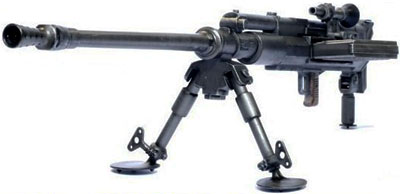
Solothurn S18-100
However, like many other German designs, this weapon did not appear under the designation “Rheinmetall”. The Treaty of Versailles did not allow Rheinmetall to produce the new product under its own brand. Even its development was a violation of the restrictions imposed on Germany. In order to conceal such work, the Germans used their branch in Switzerland, Waffenfabrik Soloturn AG (since 1929, the Soloturn company became part of the German concern Rheinmetall). The new weapon, created in Germany, began to be produced under the Swiss brand designation “Soloturn”.
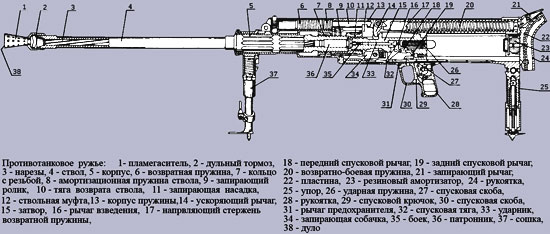
Solothurn S18-100 PTR device
In 1932, one of the variants of the gun was a heavy, self-loading, magazine anti-tank rifle designed to use the 20x105 mm cartridge.
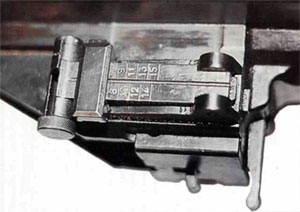
Solothurn S18-100 mechanical sight
The automation of the anti-tank rifle worked on the principle of recoil of the barrel with its short stroke. The barrel bore was locked by turning the coupling installed on the breech and coupling its lugs with the lugs of the longitudinal sliding bolt. When the barrel and bolt moved backwards under the influence of the recoil force, the protrusion of the coupling entered the inclined groove of the box, the coupling turned and unlocking took place. The barrel stopped, and the bolt continued to move backwards, the spent cartridge case was ejected, the firing mechanism was cocked and the reloading cycle ended under the action of the shock spring. For manual reloading, a swinging lever on the right side of the box was used, which was connected by a chain to a movable system. When the magazine was empty, the bolt remained in the open position. After the full magazine was inserted, the latch was unlocked. The bolt slid forward, picked up the first cartridge, inserted it into the chamber and the weapon was ready to fire again.

Muzzle brake Solothurn S18-100
The firing mechanism allowed only single fire.
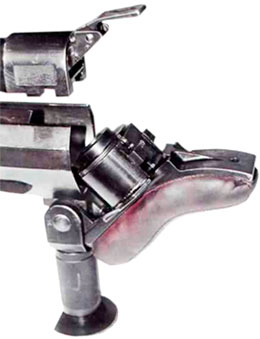
Folded shoulder rest-shock absorber
Solothurn S18-100
The weapon was fed with ammunition from detachable box magazines attached horizontally to the left. Magazines with a capacity of 5 or 10 rounds were used.
Mechanical sights consisted of an open sector-type adjustable sight designed for a range of up to 1500 m. A 2.5x optical sight could also be used, which allowed firing up to 1200 m.
The barrel was equipped with a muzzle brake. Eight right-hand rifling were made in the barrel bore.
The weapon was mounted on a bipod. For additional support and fixation of the weapon in a certain position, a folding coulter was mounted under the shoulder rest, with the ability to adjust the height.
The strong recoil of the weapon was partially compensated by a muzzle brake, a bipod assembly and a shock absorber buffer on the shoulder rest.
The practical rate of fire was 15-20 rounds per minute.
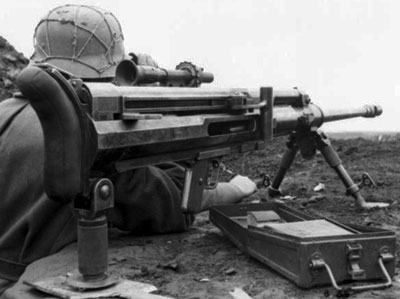
Solothurn S18-100
In battle, the gun was carried in the hands of the crew, and a special two-wheeled cart was used for transportation over long distances.
The Solothurn S18-100 anti-tank rifles had limited commercial success. They were purchased in small quantities by the armed forces of Switzerland, Germany, Hungary and Finland.
In the mid-1930s, engineers at Waffenfabrik Soloturn AG decided to improve the effectiveness of this weapon by redesigning the anti-tank rifle for more powerful 20x138 mm shells. The new anti-tank missile was designated Solothurn S18-1000, and on its basis a “universal gun” Solothurn S18-1100 was soon created, which allowed the possibility of firing in bursts and in this version was suitable for use as an anti-aircraft gun.
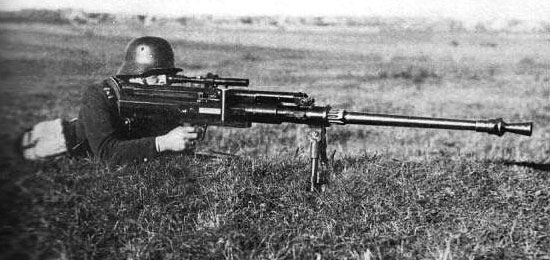
Solothurn S18-100
when using